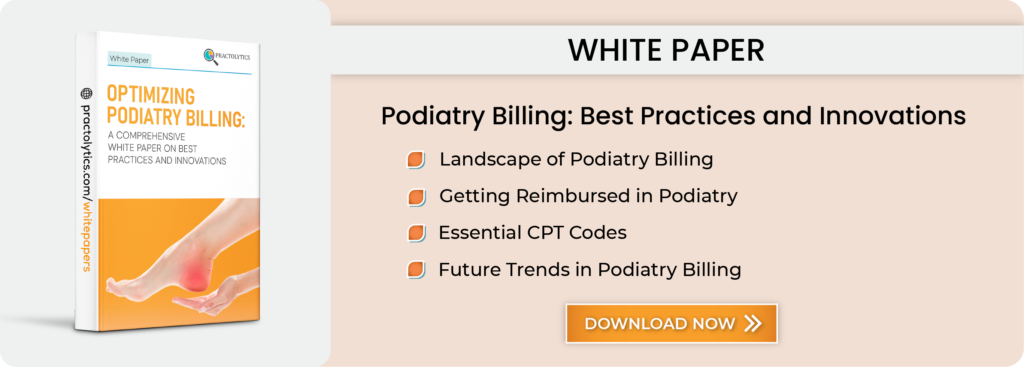Podiatry Billing Guide for Practice Success
Within the healthcare sector, podiatry billing guide for practice success is holds a vital position in ensuring individuals’ well-being which focuses on the diagnosis as well as the treatment of foot and ankle disorders. Behind the scenes, efficient and accurate podiatry billing is essential to the success of practices and healthcare professionals. Staying up to date on the key components of podiatry billing is crucial as the healthcare industry undergoes changes in regulations, reimbursement models, and technological advances.
Podiatry billing is a complicated procedure that requires an in-depth understanding of both medical practices and financial intricacies. In this blog, we will look into the crucial aspects of podiatry billing, outlining its importance and explaining the key components that practitioners and healthcare professionals must understand. Also, we will explore best practices to maximize podiatry practice reimbursement, ensuring financial success while maintaining the highest standards of patient care.
Table of Contents
Significance of Accurate and Timely Billing in Podiatry
Accurate and timely podiatry billing is crucial for any successful practice. It serves as the bridge between the services rendered by healthcare professionals and the reimbursement they receive. In an era where healthcare regulations are becoming more complex, and insurance policies are constantly evolving, ensuring the precision of billing practices is not just beneficial but imperative.
Timely billing is directly proportional to financial health. Billing delays not only have an impact on the revenue cycle, but they can also lead to compliance problems, repercussions, and strained relationships with both patients and payers. A streamlined and effective podiatry billing operation not only increases a practice’s financial viability but also builds a positive reputation in the healthcare community.
Key Components of Podiatry Billing You Need to Know!
- Coding Accuracy
One of the foundational pillars of billing is accurate podiatry coding. The right coding guarantees that the podiatric services delivered are clearly communicated to insurance companies, thereby reducing the likelihood of claim rejections and reimbursement delays. Podiatry practices must stay updated on the latest coding guidelines, including the podiatry CPT- Current Procedural Terminology and HCPCS- Healthcare Common Procedure Coding System codes.
Accurate podiatry coding extends beyond the procedures themselves; it also involves properly documenting diagnosis codes. The relationship between diagnosis and procedure codes is vital for justifying the medical necessity of the services provided, facilitating a smoother reimbursement process.
- Documentation Integrity
Comprehensive and precise documentation is vital for successful podiatry billing. Podiatrists must maintain detailed records of patient encounters, including relevant medical history, physical examinations, diagnostic tests, and treatment plans. Thorough documentation not only supports accurate coding but also serves as a shield against potential audits and investigations.
Practices should adopt Electronic Health Record (EHR) systems that promote standardized and efficient documentation processes. Utilizing templates tailored to podiatry ensures that all relevant information is captured, enhancing the overall quality of patient records.
- Insurance Verification and Eligibility Checks
Ensuring the accuracy of patient insurance information is a crucial component of successful billing. Practices should implement robust verification processes to confirm patient insurance coverage and eligibility before providing services. This proactive approach minimizes claim denials and reduces the administrative burden associated with retroactive verification.
Integration with electronic eligibility verification systems streamlines this process, providing real-time access to patient insurance information. Verifying eligibility for both primary and secondary insurance coverage mitigates the risk of delayed or denied claims, contributing to a more predictable revenue cycle.
- Claim Submission and Adjudication
Once coding and documentation are in order, the next crucial step is the submission of claims to insurance providers. Podiatry practices must be well-versed in the various payer requirements and submission protocols. Electronic claim submission is the preferred method, as it facilitates the adjudication process and minimizes the risk of errors associated with manual submissions.
Monitoring claim status and promptly addressing any issues that arise during adjudication is essential. Timely follow-up on denied or pending claims helps in identifying and rectifying discrepancies, ensuring a steady cash flow for the practice.
- Patient Billing and Communication
Effective communication with patients about their financial responsibilities is vital to a successful podiatry billing operation. A positive patient experience is facilitated by open and transparent communication concerning co-pays, deductibles, as well as any out-of-pocket expenses. Implementing user-friendly billing statements and offering multiple payment options contribute to patient satisfaction and prompt payment.
Practices need to establish proactive communication channels to address patient billing inquiries and concerns. Patients’ understanding of the billing process improves when they are educated about their insurance coverage and financial obligations, which reduces the likelihood of disagreements and payment delays.
- Compliance with Regulatory Changes
The landscape of healthcare regulations is dynamic, with frequent updates and changes. Podiatry practices must stay abreast of regulatory modifications, including changes in podiatry billing and coding guidelines, reimbursement policies, and compliance requirements. Regular training and education for staff members ensure that the practice aligns with the latest industry standards and minimizes the risk of non-compliance.
Engaging with medical associations, attending conferences, and participating in education courses are all effective ways for podiatry professionals to stay up-to-date on regulatory changes. Compliance not only reduces the possibility of penalties but also contributes to the practice’s overall integrity and reputation.
Strategies for Maximizing Reimbursement for Podiatry Practices
- Implementing Revenue Cycle Management (RCM) Systems
An effective Revenue Cycle Management (RCM) system is instrumental in maximizing podiatry practice reimbursement. RCM systems streamline the entire financial process, from appointment scheduling to claim submission and payment posting. Automation of routine tasks reduces manual errors, accelerates the revenue cycle, and enhances overall efficiency.
Choosing an RCM system tailored to podiatry practices ensures alignment with specific podiatry billing and coding, as well as documentation requirements. The integration of RCM systems with EHR platforms creates a seamless workflow, optimizing both clinical and financial aspects of the practice.
- Conducting Regular Audits and Quality Assurance
Auditing the podiatry coding and billing processes on a regular basis are crucial for identifying potential discrepancies and areas for improvement. Quality assurance helps ensure that podiatry medical coding guidelines along with documentation standards are followed. Internal audits conducted regularly by trained coders offer valuable insights into the billing process’s accuracy.
External audits by reputable third-party organizations can offer an objective evaluation of a practice’s billing operations. Identifying and addressing issues proactively through audits not only enhances billing accuracy but also reduces the risk of regulatory scrutiny and associated penalties.
- Embracing Technology for Efficiency
The incorporation of technology into podiatry billing operations is an essential component of modern medical management. Electronic Health Records (EHR), practice management systems, as well as billing software all contribute to a more simplified and efficient workflow. Regular task automation, such as scheduling appointments, coding, and claim submission, decreases administrative burdens and mitigates the possibility of human error.
Cloud-based billing solutions provide flexibility and convenience, enabling medical professionals to handle billing tasks from anywhere. Adopting technology not only improves productivity but also positions podiatry practices to adapt to changes in medical technology and regulations in the future.
- Negotiating with Payers
Proactively engaging with insurance providers to negotiate favorable reimbursement rates can positively impact the financial health of podiatry practice. Practices should leverage data on patient volume, outcomes, and quality of services to make a compelling case for fair reimbursement rates.
- Outsourcing Podiatry Billing Services
For some practices, outsourcing podiatry medical coding and billing services to specialized healthcare billing companies can be a strategic decision. Outsourcing can provide access to dedicated billing experts, reduce administrative overhead, and ensure compliance with billing regulations.
In healthcare, accurate, timely billing not only ensures the financial health of the practice but also contributes to a positive patient experience and fosters trust within the healthcare community.
Understanding and implementing the key components of podiatry billing – from accurate coding and documentation to efficient claim submission and patient communication – is essential for navigating the challenges of the modern healthcare ecosystem. Embracing best practices, such as the integration of technology, regular audits, and ongoing staff education, positions podiatry practices for sustained success in an ever-evolving industry.
As a leading Revenue Cycle Management (RCM) service provider, Practolytics understands the complexities of podiatry billing. We offer comprehensive Podiatry Billing Services, ensuring seamless technology integration, regular compliance audits, and ongoing staff training, allowing podiatry practices to optimize their financial performance while focusing on providing exceptional patient care. Podiatry practices can confidently navigate the complexities of billing with Practolytics, ensuring long-term success in today’s dynamic healthcare landscape.
ALSO READ – How Partnering with a Platinum AdvancedMD Provider Can Reduce Your Clinic’s Operational Costs?
Talk to Medical Billing Expert Today — Get a Free Demo Now!






